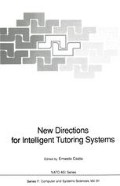Abstract
We examine here the role of the context around the learner when using an ITS facing the problem of integration of ITS in their context of uses. Questions are raised which impose constraints during Sie design of ITS themselves. For example, if a teacher is available near die learner, which role for this teacher? What about the knowledge the system has of this role? If there is a group of learners and few teachers, which representation of the available possibilities to help the learner? How to share teacher’s time between different learners? What place for possibilities of experiments and hands-on work by learners in experimental sciences? How to take account of such possibilities? We describe some possible scenarios for use and explore some needs which are generally ignored when designing ITS.
Access this chapter
Tax calculation will be finalised at checkout
Purchases are for personal use only
Preview
Unable to display preview. Download preview PDF.
References
Clanccy WJ. (1983) The epistemology of a rule based expert system - a framework for explanations, Artificial Intelligence 20, 215–251.
Courtois J. (1988) SIAM: système intelligent pour l’apprentissage du diagnostic technique, Montréal-ITS88, pp. 327–333.
Dickson P. (1990) Environments for interactive learning: the computer exploratorium, private communication.
Genesereth (1982) The role of plans in intelligent teaching systems. In Intelligent tutoring systems, D. Sleeman, J.S. Brown (eds.), Academic Press, pp. 134–155.
Mandl H., Lesgold A.M. (eds) (1988) Learning issues for intelligent tutoring systems, Springer-Verlag, New York.
Nicaud J F., Vivet M. (1988) Les tuteurs intelligents: réalisations et tendances de recherche, synthèse sur les tuteurs intelligents, revue Techniques et Science Informatiques -TSI, vol 7, n°l, Jan. 1988.
Nicolas P. (1989), Construction et vérification de figures géométriques dans le système MENTONIEZH, Thèse de l’Université de Rennes 1.
O’Shea T., Bornât R., Du Boulay B., Eisenstadt M., Page I. (1984) Tools for creating intelligent computer tutors. In: Human and artificial intelligence, Elithor, Banerjii (eds.), North-Holland.
Ohlsson S. (1986) Some principles of intelligent tutoring. Instructional Science 14, Elsevier, Amsterdam, pp. 293–326.
Papert S. (1980) Mindstorms: children, computers and powerful ideas, Basic Books, New York.
Py D. (1989), MENTONIEZH: an ITS in geometry, 4th international conference on AI & education, Amsterdam, pp. 202–209.
Ross P. (1988). Plan recognition for intelligent tutoring systems, Frascati, May 1987, Artificial Intelligence Tools in Education, P. Ercoli, R. Lewis (eds), pp. 29–38, North-Holland.
Self J. (1986). Artificial intelligence, Its potential in education and training, 5ième symposium canadien sur la technologie pédagogique, Ottawa, May 1986, pp. 69–77.
Self J. (1988a). Student Models: What Use Are They?, Frascati, May 1987, in Artificial intelligence tools in education, P. Ercoli, R. Lewis (eds.), North-Holland, pp. 73–86.
Self J. (1988b). Bypassing the intractable problem of student modelling, 4th Intematinal conference AI and Education, Amsterdam, May 1989.
Self J. (1989).The case of formalising student models (and ITS generally), ITS 88, Montreal, June 1988, pp. 18–24.
Sleeman D. and Brown J.S. (1982). Intelligent tutoring systems, Academic Press, London.
Vivet M. (1981), Apprentissage autonome, sur un usage de la technologie informatique dans l’éducation, Annexe du rapport SIMON, “Education et informatisation de la société”, La documentation française.
Vivet M. (1987a). systèmes experts pour enseigner: méta-connaissances et explications, congrès CESTA: MARI-COGNmVA 87, Paris, May 1987.
Vivet M. (1987b). Hierarchy of knowledges in an intelligent tutoring system; how to take account of the student, note interne CRIC, Presented during the European seminar on Intelligent Tutoring Systems, Tubingen, October 1987, pp. 25–31.
Vivet M. (1988a). Reasoned explanations need reasoning on reasoning and reasoning on the student,, Frascati, May 1987. Artificial intelligence tools in education, Paolo Ercoli, Robert Lewis (eds.), North-Holland (1988), pp. 121–128.
Vivet M., Futtersack M., Labat M. (1988b). Métaconnaissances dans les tuteurs intelligents. International Conference on Intelligent Tutoring Systems, Montréal, June 1988.
Vivet M. (1988c), Knowledge Based Tutors: Towards the design of a shell..., in International Journal for Educational Research and Instruction (IJERI), vol. 12, N°8, pp.839–850, 1988, Special issue edited by H. Mandl.
Vivet M. (1988d), la prise en compte du contexte avec les tuteurs intelligents, conférence invitée, Premier congrès européen “intelligence artificielle et formation”, APPLICA 88, Lille, October 1988.
Vivet M., Carrière E., Delozanne E. (1988e), presentation of different aspects of AMALIA: a knowledge based system for mathematics, European summer university on intelligent tutoring systems, Le Mans, 1988, October 26 - November 2.
Vivet M. (1988f). Examination of two ways for research in advanced educational technology, Milton Keynes, OU, NATO Workshop on Advanced Educational Technolojy, November 11–12, 1988.
Vivet M. (1989), Which goal, which pedagogical attitudes with micro-robots in a class room ?, NATO Workshop on Advanced Educational Technology Student Development Of Physics Concepts: The Role Of Educational Technology, Pavia, Italy, October 1989.
Wenger E. (1987), Artificial Intelligence and tutoring systems Computational and cognitive Approaches to the Communication of knowledge, Morgan Kaufmann.
Winans R.T., Whitaker E.T., Bonnel R.D. (1988), Theories of learning in computer-aided Instruction. Fifth International Conference on Technology and Education, Edinburgh, March 1988, pp. 86–89.
Yazdani (1986). Intelligent tutoring systems survey, AI Review 1, pp. 43–52.
Author information
Authors and Affiliations
Editor information
Editors and Affiliations
Rights and permissions
Copyright information
© 1992 Springer-Verlag Berlin Heidelberg
About this paper
Cite this paper
Vivet, M. (1992). Uses of ITS: Which Role for the Teacher?. In: Costa, E. (eds) New Directions for Intelligent Tutoring Systems. NATO ASI Series, vol 91. Springer, Berlin, Heidelberg. https://doi.org/10.1007/978-3-642-77681-6_11
Download citation
DOI: https://doi.org/10.1007/978-3-642-77681-6_11
Publisher Name: Springer, Berlin, Heidelberg
Print ISBN: 978-3-642-77683-0
Online ISBN: 978-3-642-77681-6
eBook Packages: Springer Book Archive

